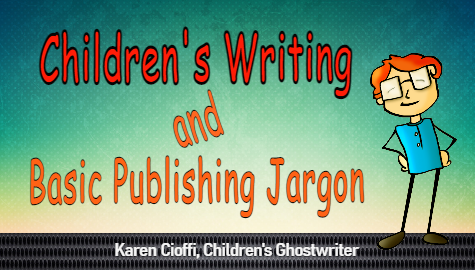The writing and publishing arena have a number of words specific to the industry, its lingo or jargon. Below are some of the most important ones for the children’s author.
1. Manuscript (MS)
This is what your draft is called once it’s complete and ready for submission.
2. Synopsis
This is a short summary of the manuscript. It’s best to try to keep it to one page.
3. Proposal
The proposal is what you’ll send an editor or agent to pitch a nonfiction book. It should be detailed and include:
-A ‘hook’ cover letter
-Table of contents
-A market analysis (why the book will be successful based on marketing aspects)
-Author bio and platform
-Outline (brief summary of each chapter)
-Completed sample chapters (submit the number of chapters the guidelines require)
4. Query
This is a one-page letter to an editor or agent explaining what your manuscript is about. It should also include a bit on who you are and what your qualifications (experiences) are for writing this particular story (if there are any). You should also include a brief paragraph on how you intend to help market the book.
For more on writing and sending queries, check out:
Be Specific and Professional When Submitting Queries
http://karencioffiwritingforchildren.com/2015/07/13/submitting-manuscript-queries/
5. Sample Chapters
These chapters should be completed and used for book proposal. For fiction work, if you an editor of agent and she is interested, she may request sample chapters. These chapters should be first ones in the story.
For nonfiction work, you can choose the chapters you feel best represent the story.
6. Platform
Your author platform is your online presence, your visibility and ability to market and sell your book. Your platform allows you to bring website traffic (visitors) to your site, build your perceived authority / expertise, and develop a relationship with readers. This includes having a social media presence also. A platform is a must for every writer.
If you need help building your platform or bringing it to the next level, check out my e-classes through WOW Women on Writing at: https://thewritingworld.com/your-author-platform/
7. Picture book (PB)
These books range from bedtime stories to ages 7 and 8. They have simple stories with one protagonist (main character). The story is told from the protagonist’s POV (point of view).
8. Easy (early) readers
These are the first ‘chapter stories’ for the beginning reader, aged around 6-8, or younger. These stories are usually between 500 and 1,500 words with illustrations here and there throughout. The story line is still kept simple and should still have only the protagonist’s POV.
9. Chapter books
These books are usually for ages 7-9, but can range from 6-12. The word count is boosted to 5,000 to under 15,000 words. Since the reader is developing her reading skills, the vocabulary, sentence structure, and story line is broadened.
10. Middle grade (MG)
These books usually cover ages 9-12. The can include more than one POV and have more complicated story lines. The word count varies. An average guideline is 20,000 (for younger middle grade) to 35,000 (for upper middle grade).
11. Young adult (YA)
This genre encompasses the twelve to sixteen and up age group. YAs can be edgy; plots and characters can be complex and serious issues addressed.
For a more detailed breakdown of children’s genres, go to:
Writing Children’s Books: Genre Differences
12. Draft
I included this additional term because some beginning writers wonder what the difference is between a draft and a manuscript.
According to Cambridge Dictionary, a draft is “a piece of writing or drawing that is done early in the development of a work to help prepare it in its final form.”
So, a draft is what you initially create and work on until it’s polished into the final manuscript.
References:
October 2014 of Writer’s Digest, “Industry Lingo” on page 22.
http://www.writersdigest.com/online-editor/the-8-essential-elements-of-a-nonfiction-book-proposal
MORE ON WRITING FOR CHILDREN
Plot and Your Story – Four Formats
Make Your Children’s Writing Website Focused – 3 Must-Haves, 6 Tips
How Do You Make a Good Story Worth of Getting Past the Gatekeeper
Let me take a look at your idea, outline, or draft. I’m a working children’s ghostwriter, rewriter, and coach. I can turn your story into a publishable book you’ll be proud to be author of.
Shoot me an email at: kcioffiventrice@gmail.com (please put Children’s Writing Help in the Subject line)
LIKE THIS POST? PLEASE SHARE!

Hi Karen, I like your blog. Good posts. Marie Bast
Thanks, Marie. Glad you like the blog!